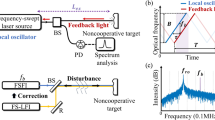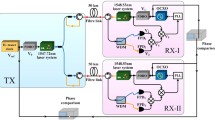Abstract
The problem of coherence violation in stroboscopic ranging with a high resolution in the range due to mutual phase instability of probing and reference radio signals has been considered. It has been shown that the violation of coherence in stroboscopic ranging systems is equivalent to the action of modulating interface and leads to a decrease in the system sensitivity. Requirements have been formulated for the coherence of reference generators in the stroboscopic processing system. The results of statistical modeling have been presented. It was shown that, in the current state of technology with stability of the frequencies of the reference generators, the achieved coherence is sufficient to probe asteroids with super-resolving signals in the range of up to 70 million kilometers. In this case, the dispersion of the signal in cosmic plasma limits the value of the linear resolution of the asteroid details at this range by the value of ~2.7 m. Comparison with the current radar resolution of asteroids has been considered, which, at the end of 2015, were ~7.5 m in the range of ~7 million kilometers.
Similar content being viewed by others
References
Marshall, S.E., Howell, E.S., Brozovich, M., et al., Potentially hazardous asteroid (85989) 1999 JD6: Radar, infrared, and lightcurve observations and a preliminary shape model, Am. Astron. Soc., DPS Meeting no. 47, 2015, id 204.09.
Morrison, D., Defending the earth against asteroids: The case for a global response, Sci. Global Secur., 2005, vol. 13, pp. 87–103.
Morrison, D., Chapman, C.R., Steel, D., and Binzel, R.P., Impacts and the public: Communicating the nature of the impact hazard, in Mitigation of Hazardous Comets and Asteroids, Belton, M.J.S., Morgan, T.H., Samarasinha N.H., and Yeomans, D.K., Eds., Cambridge: Cambridge Univ. Press, 2011, pp. 353–390.
Study to Determine the Feasibility of Extending the Search for Near-Earth Objects to Smaller Limiting Diameters, Stokes, G., Ed., Report of the NEO SDT, NASA, 2003. http://neo.jpl.nasa.gov/neo/neore port030825.pdf.
Taylor, P.A., Richardson, J.E., Rivera-Valentín, E.G., et al., Radar observations of near-earth asteroids from Arecibo and Goldstone, 47th Lunar and Planetary Science Conference: The Woodlands, Texas, 2016, LPI Contribution no. 1903, pp. 2772–2772.
Zakharchenko, V.D., Stroboscopic selection of broadband RF signals with coherent probing, in 21st International Crimean Conference: Microwave and Telecommunication Technology (CriMiCo-2011), id 6068856, pp. 1124–1125.
Zakharchenko, V.D. and Kovalenko, I.G., On protecting the planet against cosmic attack: Ultrafast real-time estimate of the asteroid’s radial velocity, Acta Astronaut., 2014, vol. 98, pp. 158–162.
Zakharchenko, V.D., Kovalenko, I.G., and Pak, O.V., Estimate of sizes of small asteroids (cosmic bodies) by the method of stroboscopic radiolocation, Acta Astronaut., 2015, vol. 108, pp. 57–61.
Belov, L., Reference generators, Elektron.: Nauka, Tekhnol., Biznes, 2004, no. 6, pp. 38–44.
Veter solnechnyi. Sostav, kontsentratsiya chastits i skorost’. GOST 25645.136-86 (Solar Wind: The Composition, Particle Concentrations and Velocity. GOST 25645.136-86), Moscow: Izd. standartov, 1986.
Gonorovskii, I.S., Radiotekhnicheskie tsepi i signaly (Radio Engineering Circuits and Signals), Moscow: Drofa, 2006.
Zakharchenko, V.D., Self-gating of fast-moving targets in early warning radio engineering systems, Fiz. Volnovykh Protsessov Radiotekh. Syst., 1999, vol. 2, nos. 3–4, pp. 34–39.
Zakharchenko, V.D. and Kovalenko, I.G., RF Patent no. 2527252, Izobret., Polezn. Modeli, 2014, no. 24.
Zakharchenko, V.D. and Ryzhkov, V.Yu., The phasesensitive operating mode of the radio pulse converter of a stroboscopic radar system, Radiotekh. Telekommun. Syst., 2015. no. 3, pp. 20–25.
Kazakov, V.A., Vvedenie v teoriyu markovskikh porocessov i nekotorye radiotekhnicheskie zadachi (Introduction to the Theory of Markov Processes and Some Radio Engineering Problems), Moscow: Sov. radio, 1973.
Lazorenko, O.V. and Chernogor, L.F., Ultra-wideband signals and physical processes. 1. Basic concepts, models, and description methods, Radiofiz. Radioastron., 2008, vol. 13, no. 2, pp. 166–194.
Naidenov, A.I., Transformatsiya spektra nanosekundnykh impul’sov (Transformation of Nanosecond Pulse Spectra), Moscow: Sov. radio, 1973.
Ryabinin, Yu.A., Stroboskopicheskoe ostsillografirovanie (Stroboscopic Oscillography), Moscow: Sov. radio, 1972.
Samko, S.G., Kilbas, A.A., and Marichev, O.I., Integraly i proizvodnye drobnogo poryadka i nekotorye ikh prilozheniya (Integrals and Derivatives of Fractional Order and Some of Their Applications), Minsk: Nauka i tekhnika, 1987.
Shustov, B.M., Naroenkov, S.A., Emel’yanenko, V.V., and Shugarov, A.S., Astronomical aspects of building a system for detecting and monitoring hazardous space objects, Sol. Syst. Res., 2013, vol. 47, no. 4, pp. 288–295.
Author information
Authors and Affiliations
Corresponding author
Additional information
Original Russian Text © V.D. Zakharchenko, I.G. Kovalenko, O.V. Pak, V.Yu. Ryzhkov, 2018, published in Kosmicheskie Issledovaniya, 2018, Vol. 56, No. 3, pp. 209–217.
Rights and permissions
About this article
Cite this article
Zakharchenko, V.D., Kovalenko, I.G., Pak, O.V. et al. Fundamental Constraints on the Coherence of Probing Signals in the Problem of Maximizing the Resolution and Range in the Stroboscopic Range of Asteroids. Cosmic Res 56, 190–198 (2018). https://doi.org/10.1134/S0010952518030085
Received:
Published:
Issue Date:
DOI: https://doi.org/10.1134/S0010952518030085




